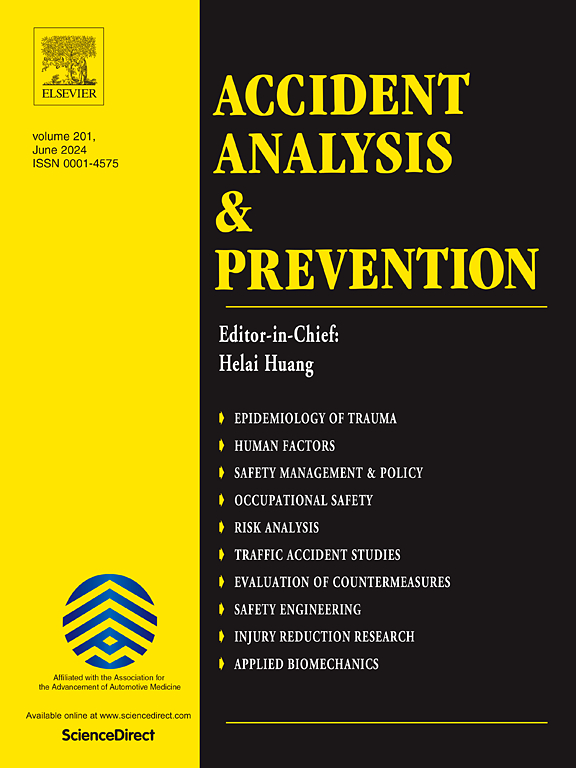Opposing-through crash risk forecasting using artificial intelligence-based video analytics for real-time application: integrating generalized extreme value theory and time series forecasting models
IF 6.2
1区 工程技术
Q1 ERGONOMICS
引用次数: 0
Abstract
Recent advancements in artificial intelligence (AI) and traffic sensing technologies provide significant opportunities for real-time crash risk forecasting. While forecasting based on historical crash data yields macroscopic insights into future crash risks, such information is often insufficient for real-time applications. In contrast, traffic conflict techniques (TCTs) leveraged by extreme value theory (EVT) and AI-based video analytics have enabled crash risk estimation to a granular level, presenting a promising potential for real-time applications. This study develops a unified framework of integrating generalized extreme value (GEV) theory with parametric and non-parametric forecasting models to predict opposing-through crash risks at signalized intersections. A deep neural network-based computer vision technique was employed to extract post encroachment time (PET) traffic conflicts from 97 h of video footage. Crash risks were estimated using a non-stationary GEV model, incorporating traffic conflict counts, speed variations, and signal timing characteristics. These risk estimates were then forecasted using autoregressive integrated moving average (ARIMA), gated recurrent unit (GRU), and long short-term memory (LSTM) models to analyze short-term crash trends. Results show that the mean crash frequency estimates fell within the 95 % confidence limits of observed crashes and confirm the adequacy of the developed EVT model in estimating opposing-through crashes. The autoregressive and recurrent neural network models exhibit similar forecasting accuracy for crash risk forecasting, with reliable predictions extending up to 11 future signal cycles. The proposed real-time crash risk forecasting framework can be a crucial component of an intelligent transport system, leading to proactive safety management for signalized intersections.
基于人工智能视频分析的实时碰撞风险预测:整合广义极值理论和时间序列预测模型
人工智能(AI)和交通传感技术的最新进展为实时碰撞风险预测提供了重要机会。虽然基于历史碰撞数据的预测可以产生对未来碰撞风险的宏观见解,但这些信息通常不足以用于实时应用。相比之下,利用极值理论(EVT)和基于人工智能的视频分析的交通冲突技术(tct)使碰撞风险评估达到了颗粒级,为实时应用提供了广阔的潜力。本文建立了一个统一的框架,将广义极值(GEV)理论与参数和非参数预测模型相结合,以预测信号交叉口的逆向碰撞风险。采用基于深度神经网络的计算机视觉技术,从97 h的视频片段中提取了侵犯后时间(PET)交通冲突。碰撞风险使用非平稳GEV模型进行估计,该模型结合了交通冲突计数、速度变化和信号时序特征。然后使用自回归综合移动平均(ARIMA)、门控循环单元(GRU)和长短期记忆(LSTM)模型预测这些风险估计,以分析短期崩溃趋势。结果表明,平均碰撞频率估计落在观察到的碰撞的95%置信范围内,并证实了所开发的EVT模型在估计反向碰撞方面的充分性。自回归和递归神经网络模型在碰撞风险预测方面表现出相似的预测精度,可靠的预测可延伸至11个未来信号周期。所提出的实时碰撞风险预测框架可以成为智能交通系统的重要组成部分,为信号交叉口提供主动安全管理。
本文章由计算机程序翻译,如有差异,请以英文原文为准。
求助全文
约1分钟内获得全文
求助全文
来源期刊

Accident; analysis and prevention
Multiple-
CiteScore
11.90
自引率
16.90%
发文量
264
审稿时长
48 days
期刊介绍:
Accident Analysis & Prevention provides wide coverage of the general areas relating to accidental injury and damage, including the pre-injury and immediate post-injury phases. Published papers deal with medical, legal, economic, educational, behavioral, theoretical or empirical aspects of transportation accidents, as well as with accidents at other sites. Selected topics within the scope of the Journal may include: studies of human, environmental and vehicular factors influencing the occurrence, type and severity of accidents and injury; the design, implementation and evaluation of countermeasures; biomechanics of impact and human tolerance limits to injury; modelling and statistical analysis of accident data; policy, planning and decision-making in safety.
 求助内容:
求助内容: 应助结果提醒方式:
应助结果提醒方式:


